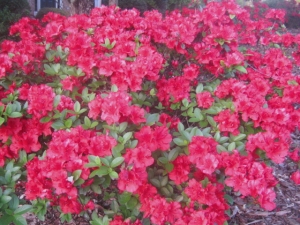 This popular Southern Indian hybrid is named ‘Formosa.’ Photo by Van Chaplin.
This popular Southern Indian hybrid is named ‘Formosa.’ Photo by Van Chaplin.
Kinds of Evergreen Azaleas
Almost all evergreen azaleas are hybrids and there are thousands of them. But the vast majority of azaleas people grow fall into one of three classes. Kurume hybrids, like ‘Coral Bells,’ ‘ Hinodegiri,’ and ‘Hershey’s Red,’ are dense, slow growers with small leaves. They bloom early and profusely in spring, flowers hiding the foliage, and grow to about 4 feet tall and wide. Southern Indian hybrids, like ‘George Lindley Taber’ and ‘Formosa,’ are less dense and bloom a little later. They have larger leaves and flowers, grow much faster, and at least get twice as big. Reblooming hybrids, like the Encores, bloom in both spring and fall with their fall blooms being more profuse. Their flowers and leaves are similar in size to those of the Southern Indians, while the bushes themselves grow about as big as Kurumes.
Which ones should you grow? That depends on how cold winters get in your area. Of the types discussed here, Kurumes are the most cold-hardy, tolerating temps down to around 0 degrees. Encores take temps down to about 5-10 degrees. Southern Indians take temps down to 15-20 degrees. How long it stays cold also plays a role. One night of 5 degrees might by OK. Seven straights nights could be fatal.
The Right Light
Books often describe azaleas as shade plants. This is misleading. While azaleas will grow in full shade, they won’t bloom there. Give them at least a half-day of sun or a whole day of high, filtered shade. In most places, they’ll also grow in full sun if planted in moist, fertile soil. Jimmy Turner, garden guru at the Dallas Arboretum, says Encores do great in full sun there. And Dallas has cloudless summers with temps often exceeding 100 degrees.
The Right Soil
Azaleas like moist, fertile, well-drained soil that contains lots of organic matter. The soil must be acid with a pH around 5.5 to 6.2. Alkaline soil turns their leaves yellow between the veins, a condition called chlorosis. Due to lack of chlorophyll, the leaves cannot photosynthesize to make food and the plants slowly starve. If you have alkaline soil but still want azaleas, either grow them in pots or plant them in raised beds to which you’ve added garden sulfur to make the soil acid.
The Right Moisture
While evergreen azaleas take more drought than native ones, they have shallow roots and don’t like dry soil. Soak the roots to prevent wilting during summer droughts. Adding a 2-inch layer of mulch beneath them will help keep the soil moist and cool.
The Right Fertilizer
If you have great soil with lots of organic matter, fertilizing isn’t necessary. If you don’t, apply an acid-forming, azalea fertilizer right after the azaleas finish blooming. Follow the label directions.
When to Prune
Most azaleas bloom on flower buds made the previous year. Prune them shortly after they finish blooming in spring. If you prune in summer or fall, you won’t get flowers the following spring. Rebloomers like the Encores, however, bloom on both last year’s growth and the current year’s. If you need to prune them, do so soon after the spring bloom. You’ll get flowers in fall and again the next spring. Read more information about pruning azaleas and watch the video below to learn more about caring for Azaleas.